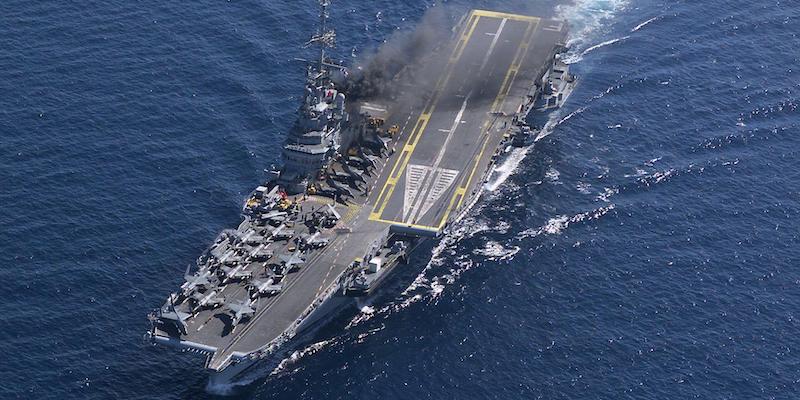On Friday, the Brazilian navy sank a decommissioned aircraft carrier in the Atlantic Ocean, 350 kilometers away from the Brazilian coast, in an area that reaches depths of around 5,000 metres. The São Paulo was a ship built in France in the late 1950s and contained large quantities of asbestos, widely used at the time as a building material due to its fireproof properties and only later revealed to be a powerful carcinogen. In recent years Brazil had been looking for a place to dismantle it safely, but after a series of failures on Thursday it decided to sink it in a controlled way, despite protests from various environmental groups.
From 1963 to 2000, São Paulo had been a ship of the French Navy. She is 266 meters long, originally she was called Foch and with that name she took part in tests with French nuclear bombs in the Pacific Ocean in the 1960s and was used in Africa, the Middle East and during the Balkan war in the 1990s . Then she was bought by Brazil, but in 2005 a fire that broke out on board damaged her a lot and she had not been used for about a decade, although she had only been officially out of service since 2018. Since then, such quantities of gas had accumulated in some of the ship’s rooms toxic enough to make it dangerous even to enter, according to the evaluations of the inspectors who had judged the conditions.
In 2021 Brazil had agreed with the companies MSK Maritime Services & Trading and Sok Denizcilik to have the ship demolished, dispose of the asbestos and recycle in Turkey part of the metals of which it was made (those not contaminated by toxic substances).
However, last August, after some environmental protests according to which the São Paulo contained many more dangerous substances than declared, and as the aircraft carrier was about to enter the Mediterranean Sea being towed by another ship, its voyage was interrupted by the Ministry of Environment, Urbanization and Climate Change from Turkey: the Turkish authorities had asked the Brazilian ones for a new report on the dangerous substances present on board, and dissatisfied with the reply, they had canceled the ship’s import permits.
The protests were due to suspicions that there was much more asbestos on the São Paulo than the scant 10 tons estimated by inspectors. In an aircraft carrier of the same class as the São Paulo, the Clemenceau, dismantled in the 2000s, there were more than 45 tons of asbestos. The Brazilian navy had said that some of the asbestos on the São Paulo had been removed over the years, but had not provided proof, and Grieg Green, the Norwegian company that had carried out the inspections, had said that, not being able to access all the rooms of the ship for safety reasons, he had only made an estimate of the asbestos present: “There could be much more”.
Unable to go to Turkey, the ship had been taken back to South America, but not to the port of Rio de Janeiro, from where it had originally departed. Due to the environmental risks reported by environmental organizations, no Brazilian local authority wanted to grant access to the ports, so although after the two Atlantic crossings it was necessary to dock her to carry out a minimum of maintenance, since October the São Paulo was off the coast north-eastern parts of Brazil, continuing to move in a circle with its tug.
Not even the Brazilian navy had made its bases available: it had not explained why but it had justified itself by saying that by now the aircraft carrier no longer belonged to it, having been sold to MSK and Sok Denizcilik.
In December, the ship had been moved further from the coast, about 300 kilometers away, for fear that it would have sunk, creating problems for navigation: in the meantime, in fact, her conditions had deteriorated greatly. Last month, as the vessel continued to go in circles burning 20 tons of fuel every day from its tug, MSK said it lost $5 million in the whole story. Two weeks ago the navy estimated that the aircraft carrier could only hold out another month before sinking. Finally this week it was decided to sink it in a controlled way to limit the damage, despite new environmental protests brought before the organizations Greenpeace and Sea Shepherd according to which the sinking would have caused great damage to marine environments.
However, the Brazilian authorities assessed that it was the only possible solution and that it was better to choose the point where it would sink.
🚨SERIOUS: Once again the importance of protecting the oceans has been NEGLECTED. The Brazilian Navy sank today (3) the aircraft carrier NAe São Paulo in the Atlantic Ocean, 350km off the Brazilian coast.
— Greenpeace Brasil (@GreenpeaceBR) February 4, 2023
